Emotional Intelligence and Strategic Leadership in Organizations
VerifiedAdded on 2022/10/19
|8
|2640
|15
Report
AI Summary
This report explores the critical role of emotional intelligence (EI) in effective leadership and strategic decision-making within organizations. It highlights the key components of EI, including self-awareness, self-management, social awareness, and relationship management, and their impact on employee motivation, conflict resolution, and overall organizational performance. The report emphasizes that leaders with high EI can inspire their teams, foster positive work environments, and align individual and organizational goals. It also discusses the teachability of EI, the importance of leaders understanding their own emotions and those of their employees, and provides real-world examples of leaders who effectively utilize EI. Furthermore, the report references various studies and research findings that support the positive correlation between EI and organizational success, including increased employee engagement, reduced turnover, and improved profitability. The report concludes by underscoring the significance of EI in modern leadership and its contribution to long-term career development and organizational growth.
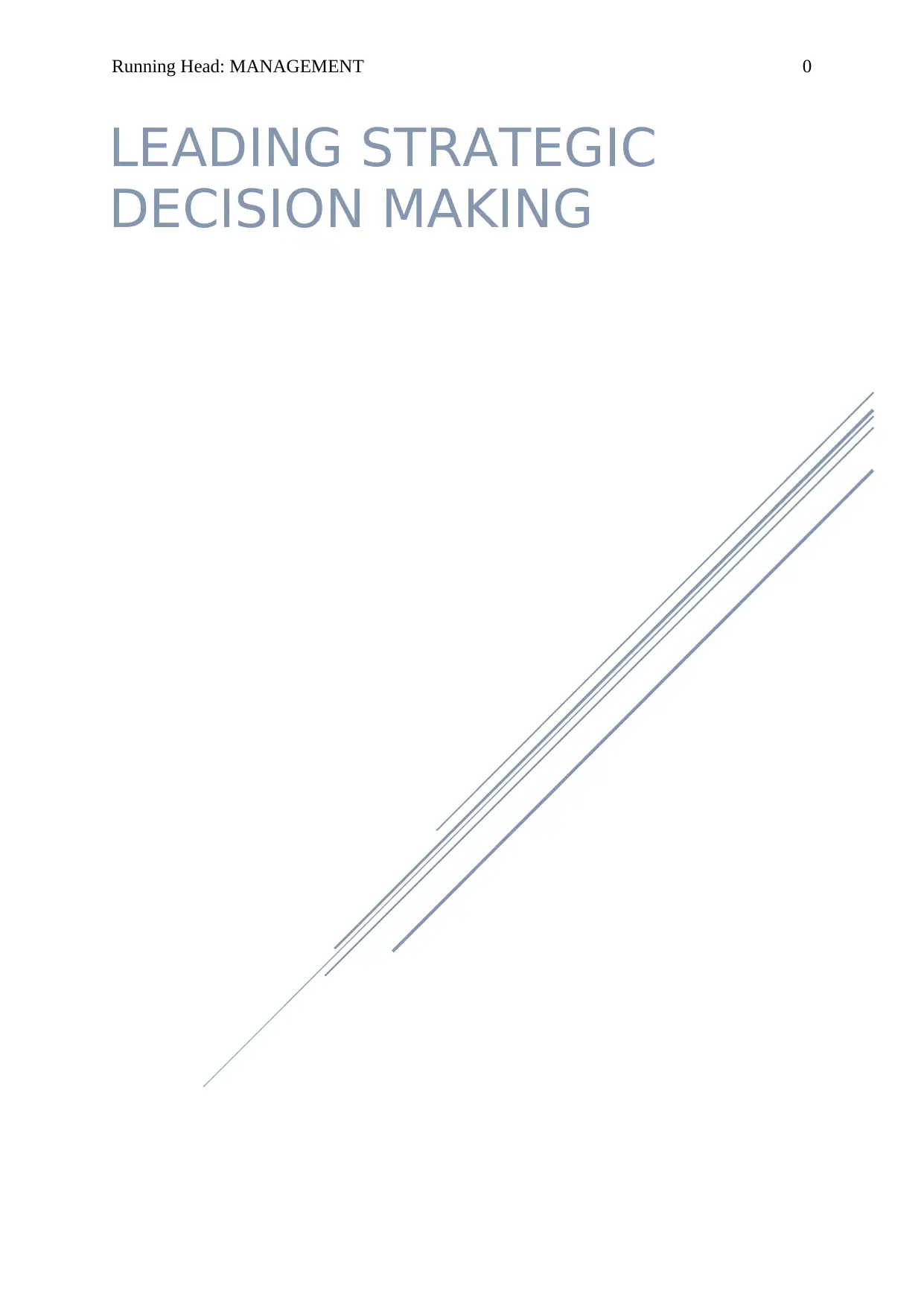
Running Head: MANAGEMENT 0
LEADING STRATEGIC
DECISION MAKING
LEADING STRATEGIC
DECISION MAKING
Paraphrase This Document
Need a fresh take? Get an instant paraphrase of this document with our AI Paraphraser
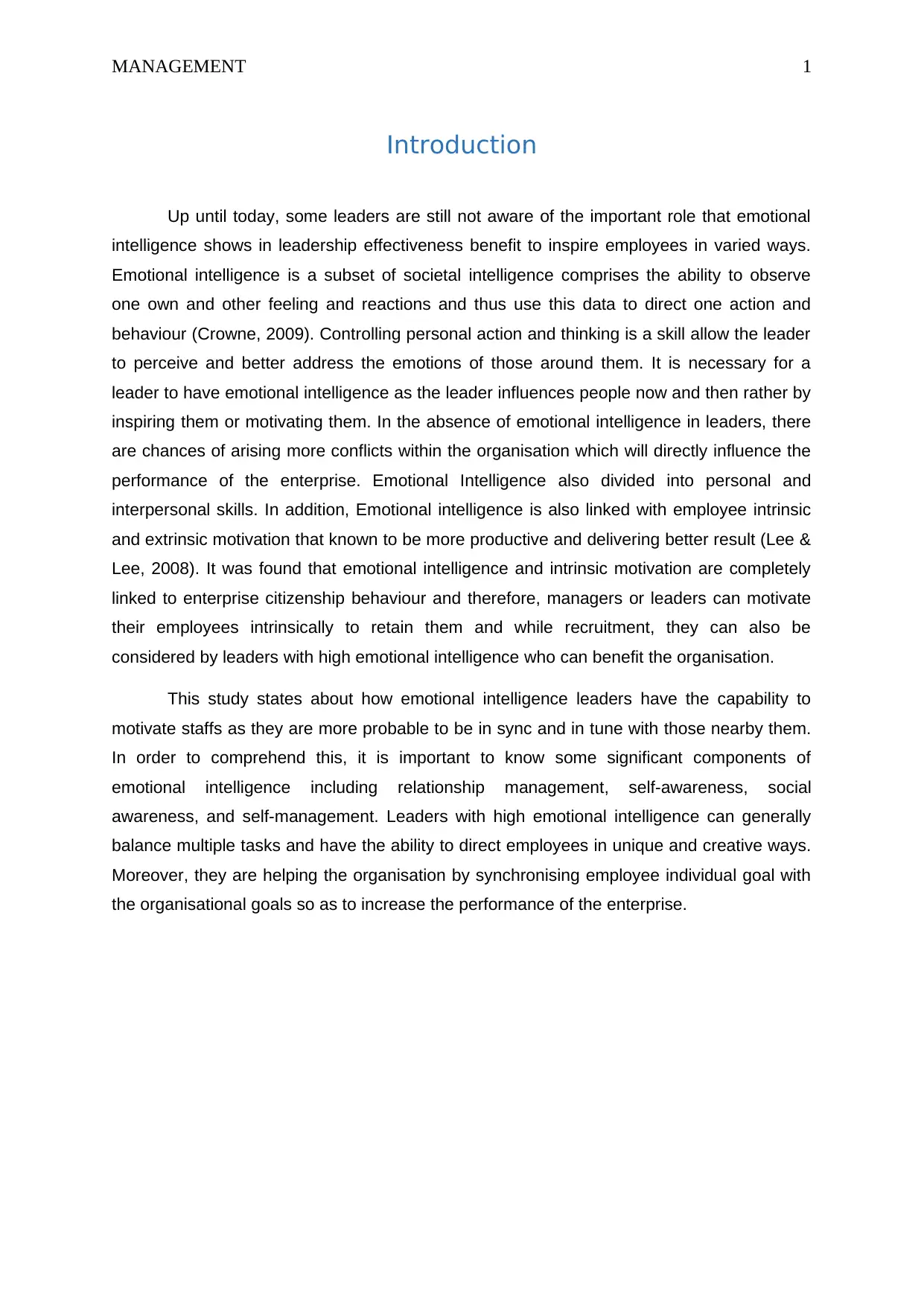
MANAGEMENT 1
Introduction
Up until today, some leaders are still not aware of the important role that emotional
intelligence shows in leadership effectiveness benefit to inspire employees in varied ways.
Emotional intelligence is a subset of societal intelligence comprises the ability to observe
one own and other feeling and reactions and thus use this data to direct one action and
behaviour (Crowne, 2009). Controlling personal action and thinking is a skill allow the leader
to perceive and better address the emotions of those around them. It is necessary for a
leader to have emotional intelligence as the leader influences people now and then rather by
inspiring them or motivating them. In the absence of emotional intelligence in leaders, there
are chances of arising more conflicts within the organisation which will directly influence the
performance of the enterprise. Emotional Intelligence also divided into personal and
interpersonal skills. In addition, Emotional intelligence is also linked with employee intrinsic
and extrinsic motivation that known to be more productive and delivering better result (Lee &
Lee, 2008). It was found that emotional intelligence and intrinsic motivation are completely
linked to enterprise citizenship behaviour and therefore, managers or leaders can motivate
their employees intrinsically to retain them and while recruitment, they can also be
considered by leaders with high emotional intelligence who can benefit the organisation.
This study states about how emotional intelligence leaders have the capability to
motivate staffs as they are more probable to be in sync and in tune with those nearby them.
In order to comprehend this, it is important to know some significant components of
emotional intelligence including relationship management, self-awareness, social
awareness, and self-management. Leaders with high emotional intelligence can generally
balance multiple tasks and have the ability to direct employees in unique and creative ways.
Moreover, they are helping the organisation by synchronising employee individual goal with
the organisational goals so as to increase the performance of the enterprise.
Introduction
Up until today, some leaders are still not aware of the important role that emotional
intelligence shows in leadership effectiveness benefit to inspire employees in varied ways.
Emotional intelligence is a subset of societal intelligence comprises the ability to observe
one own and other feeling and reactions and thus use this data to direct one action and
behaviour (Crowne, 2009). Controlling personal action and thinking is a skill allow the leader
to perceive and better address the emotions of those around them. It is necessary for a
leader to have emotional intelligence as the leader influences people now and then rather by
inspiring them or motivating them. In the absence of emotional intelligence in leaders, there
are chances of arising more conflicts within the organisation which will directly influence the
performance of the enterprise. Emotional Intelligence also divided into personal and
interpersonal skills. In addition, Emotional intelligence is also linked with employee intrinsic
and extrinsic motivation that known to be more productive and delivering better result (Lee &
Lee, 2008). It was found that emotional intelligence and intrinsic motivation are completely
linked to enterprise citizenship behaviour and therefore, managers or leaders can motivate
their employees intrinsically to retain them and while recruitment, they can also be
considered by leaders with high emotional intelligence who can benefit the organisation.
This study states about how emotional intelligence leaders have the capability to
motivate staffs as they are more probable to be in sync and in tune with those nearby them.
In order to comprehend this, it is important to know some significant components of
emotional intelligence including relationship management, self-awareness, social
awareness, and self-management. Leaders with high emotional intelligence can generally
balance multiple tasks and have the ability to direct employees in unique and creative ways.
Moreover, they are helping the organisation by synchronising employee individual goal with
the organisational goals so as to increase the performance of the enterprise.
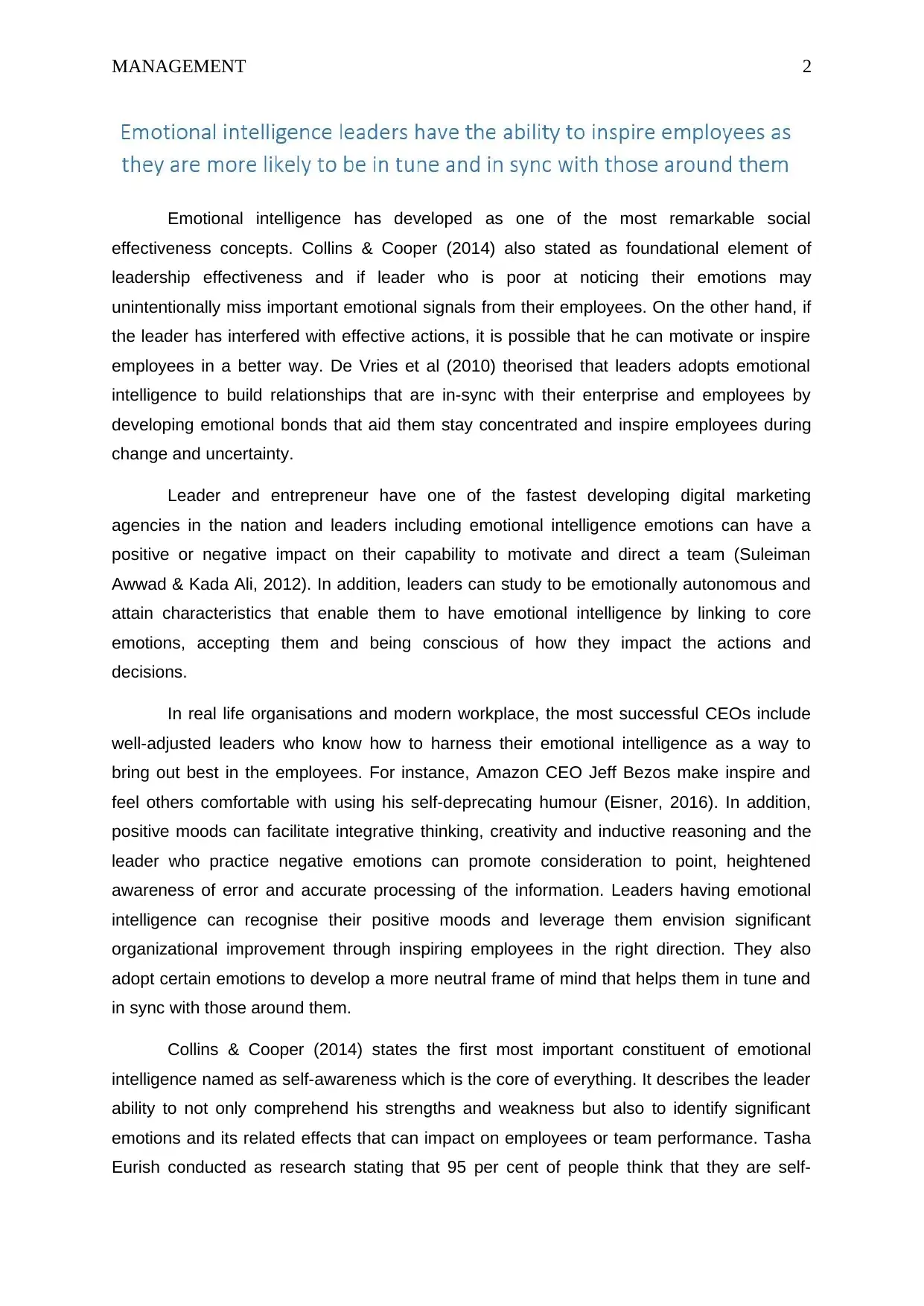
MANAGEMENT 2
Emotional intelligence has developed as one of the most remarkable social
effectiveness concepts. Collins & Cooper (2014) also stated as foundational element of
leadership effectiveness and if leader who is poor at noticing their emotions may
unintentionally miss important emotional signals from their employees. On the other hand, if
the leader has interfered with effective actions, it is possible that he can motivate or inspire
employees in a better way. De Vries et al (2010) theorised that leaders adopts emotional
intelligence to build relationships that are in-sync with their enterprise and employees by
developing emotional bonds that aid them stay concentrated and inspire employees during
change and uncertainty.
Leader and entrepreneur have one of the fastest developing digital marketing
agencies in the nation and leaders including emotional intelligence emotions can have a
positive or negative impact on their capability to motivate and direct a team (Suleiman
Awwad & Kada Ali, 2012). In addition, leaders can study to be emotionally autonomous and
attain characteristics that enable them to have emotional intelligence by linking to core
emotions, accepting them and being conscious of how they impact the actions and
decisions.
In real life organisations and modern workplace, the most successful CEOs include
well-adjusted leaders who know how to harness their emotional intelligence as a way to
bring out best in the employees. For instance, Amazon CEO Jeff Bezos make inspire and
feel others comfortable with using his self-deprecating humour (Eisner, 2016). In addition,
positive moods can facilitate integrative thinking, creativity and inductive reasoning and the
leader who practice negative emotions can promote consideration to point, heightened
awareness of error and accurate processing of the information. Leaders having emotional
intelligence can recognise their positive moods and leverage them envision significant
organizational improvement through inspiring employees in the right direction. They also
adopt certain emotions to develop a more neutral frame of mind that helps them in tune and
in sync with those around them.
Collins & Cooper (2014) states the first most important constituent of emotional
intelligence named as self-awareness which is the core of everything. It describes the leader
ability to not only comprehend his strengths and weakness but also to identify significant
emotions and its related effects that can impact on employees or team performance. Tasha
Eurish conducted as research stating that 95 per cent of people think that they are self-
Emotional intelligence has developed as one of the most remarkable social
effectiveness concepts. Collins & Cooper (2014) also stated as foundational element of
leadership effectiveness and if leader who is poor at noticing their emotions may
unintentionally miss important emotional signals from their employees. On the other hand, if
the leader has interfered with effective actions, it is possible that he can motivate or inspire
employees in a better way. De Vries et al (2010) theorised that leaders adopts emotional
intelligence to build relationships that are in-sync with their enterprise and employees by
developing emotional bonds that aid them stay concentrated and inspire employees during
change and uncertainty.
Leader and entrepreneur have one of the fastest developing digital marketing
agencies in the nation and leaders including emotional intelligence emotions can have a
positive or negative impact on their capability to motivate and direct a team (Suleiman
Awwad & Kada Ali, 2012). In addition, leaders can study to be emotionally autonomous and
attain characteristics that enable them to have emotional intelligence by linking to core
emotions, accepting them and being conscious of how they impact the actions and
decisions.
In real life organisations and modern workplace, the most successful CEOs include
well-adjusted leaders who know how to harness their emotional intelligence as a way to
bring out best in the employees. For instance, Amazon CEO Jeff Bezos make inspire and
feel others comfortable with using his self-deprecating humour (Eisner, 2016). In addition,
positive moods can facilitate integrative thinking, creativity and inductive reasoning and the
leader who practice negative emotions can promote consideration to point, heightened
awareness of error and accurate processing of the information. Leaders having emotional
intelligence can recognise their positive moods and leverage them envision significant
organizational improvement through inspiring employees in the right direction. They also
adopt certain emotions to develop a more neutral frame of mind that helps them in tune and
in sync with those around them.
Collins & Cooper (2014) states the first most important constituent of emotional
intelligence named as self-awareness which is the core of everything. It describes the leader
ability to not only comprehend his strengths and weakness but also to identify significant
emotions and its related effects that can impact on employees or team performance. Tasha
Eurish conducted as research stating that 95 per cent of people think that they are self-
⊘ This is a preview!⊘
Do you want full access?
Subscribe today to unlock all pages.

Trusted by 1+ million students worldwide
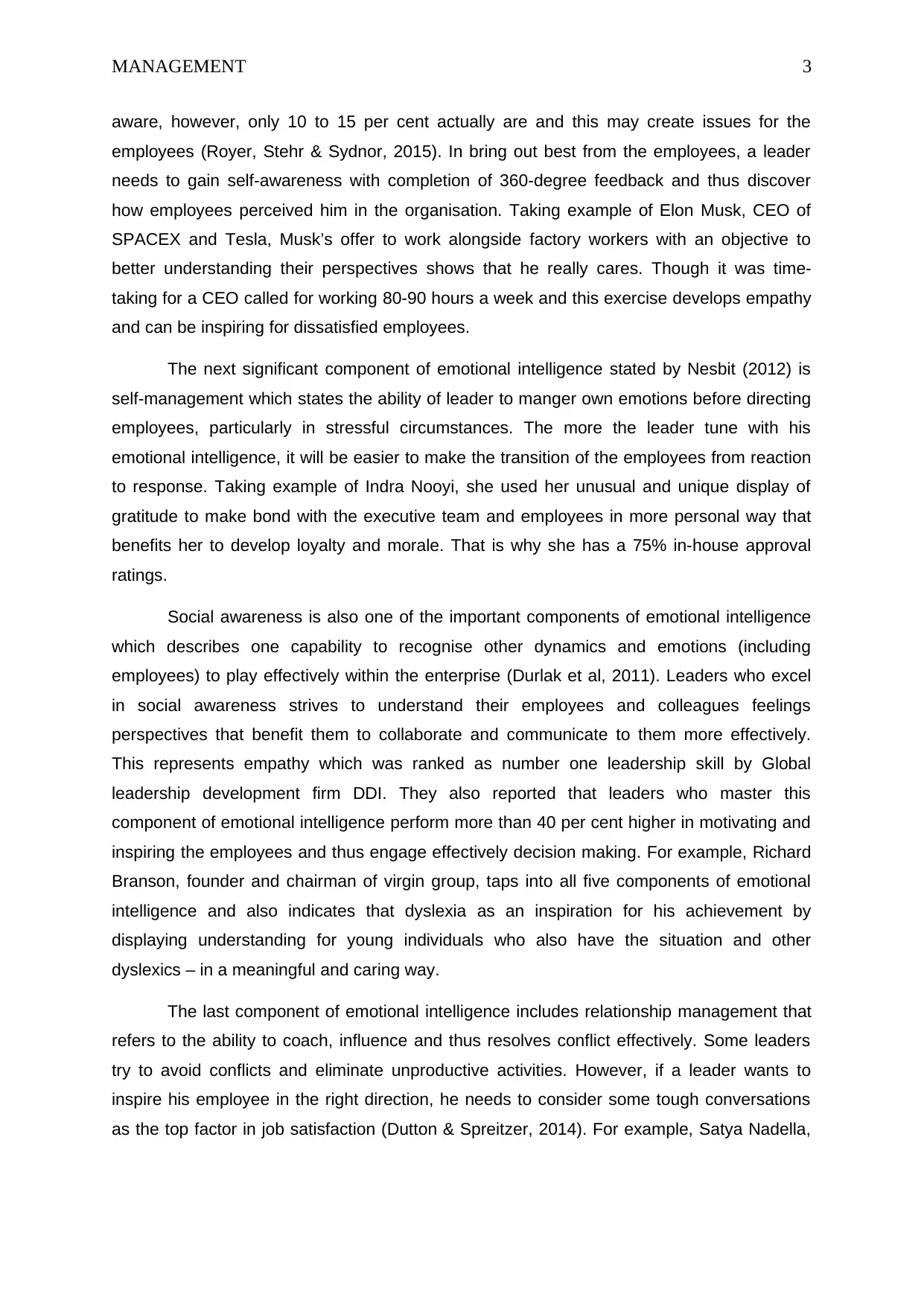
MANAGEMENT 3
aware, however, only 10 to 15 per cent actually are and this may create issues for the
employees (Royer, Stehr & Sydnor, 2015). In bring out best from the employees, a leader
needs to gain self-awareness with completion of 360-degree feedback and thus discover
how employees perceived him in the organisation. Taking example of Elon Musk, CEO of
SPACEX and Tesla, Musk’s offer to work alongside factory workers with an objective to
better understanding their perspectives shows that he really cares. Though it was time-
taking for a CEO called for working 80-90 hours a week and this exercise develops empathy
and can be inspiring for dissatisfied employees.
The next significant component of emotional intelligence stated by Nesbit (2012) is
self-management which states the ability of leader to manger own emotions before directing
employees, particularly in stressful circumstances. The more the leader tune with his
emotional intelligence, it will be easier to make the transition of the employees from reaction
to response. Taking example of Indra Nooyi, she used her unusual and unique display of
gratitude to make bond with the executive team and employees in more personal way that
benefits her to develop loyalty and morale. That is why she has a 75% in-house approval
ratings.
Social awareness is also one of the important components of emotional intelligence
which describes one capability to recognise other dynamics and emotions (including
employees) to play effectively within the enterprise (Durlak et al, 2011). Leaders who excel
in social awareness strives to understand their employees and colleagues feelings
perspectives that benefit them to collaborate and communicate to them more effectively.
This represents empathy which was ranked as number one leadership skill by Global
leadership development firm DDI. They also reported that leaders who master this
component of emotional intelligence perform more than 40 per cent higher in motivating and
inspiring the employees and thus engage effectively decision making. For example, Richard
Branson, founder and chairman of virgin group, taps into all five components of emotional
intelligence and also indicates that dyslexia as an inspiration for his achievement by
displaying understanding for young individuals who also have the situation and other
dyslexics – in a meaningful and caring way.
The last component of emotional intelligence includes relationship management that
refers to the ability to coach, influence and thus resolves conflict effectively. Some leaders
try to avoid conflicts and eliminate unproductive activities. However, if a leader wants to
inspire his employee in the right direction, he needs to consider some tough conversations
as the top factor in job satisfaction (Dutton & Spreitzer, 2014). For example, Satya Nadella,
aware, however, only 10 to 15 per cent actually are and this may create issues for the
employees (Royer, Stehr & Sydnor, 2015). In bring out best from the employees, a leader
needs to gain self-awareness with completion of 360-degree feedback and thus discover
how employees perceived him in the organisation. Taking example of Elon Musk, CEO of
SPACEX and Tesla, Musk’s offer to work alongside factory workers with an objective to
better understanding their perspectives shows that he really cares. Though it was time-
taking for a CEO called for working 80-90 hours a week and this exercise develops empathy
and can be inspiring for dissatisfied employees.
The next significant component of emotional intelligence stated by Nesbit (2012) is
self-management which states the ability of leader to manger own emotions before directing
employees, particularly in stressful circumstances. The more the leader tune with his
emotional intelligence, it will be easier to make the transition of the employees from reaction
to response. Taking example of Indra Nooyi, she used her unusual and unique display of
gratitude to make bond with the executive team and employees in more personal way that
benefits her to develop loyalty and morale. That is why she has a 75% in-house approval
ratings.
Social awareness is also one of the important components of emotional intelligence
which describes one capability to recognise other dynamics and emotions (including
employees) to play effectively within the enterprise (Durlak et al, 2011). Leaders who excel
in social awareness strives to understand their employees and colleagues feelings
perspectives that benefit them to collaborate and communicate to them more effectively.
This represents empathy which was ranked as number one leadership skill by Global
leadership development firm DDI. They also reported that leaders who master this
component of emotional intelligence perform more than 40 per cent higher in motivating and
inspiring the employees and thus engage effectively decision making. For example, Richard
Branson, founder and chairman of virgin group, taps into all five components of emotional
intelligence and also indicates that dyslexia as an inspiration for his achievement by
displaying understanding for young individuals who also have the situation and other
dyslexics – in a meaningful and caring way.
The last component of emotional intelligence includes relationship management that
refers to the ability to coach, influence and thus resolves conflict effectively. Some leaders
try to avoid conflicts and eliminate unproductive activities. However, if a leader wants to
inspire his employee in the right direction, he needs to consider some tough conversations
as the top factor in job satisfaction (Dutton & Spreitzer, 2014). For example, Satya Nadella,
Paraphrase This Document
Need a fresh take? Get an instant paraphrase of this document with our AI Paraphraser
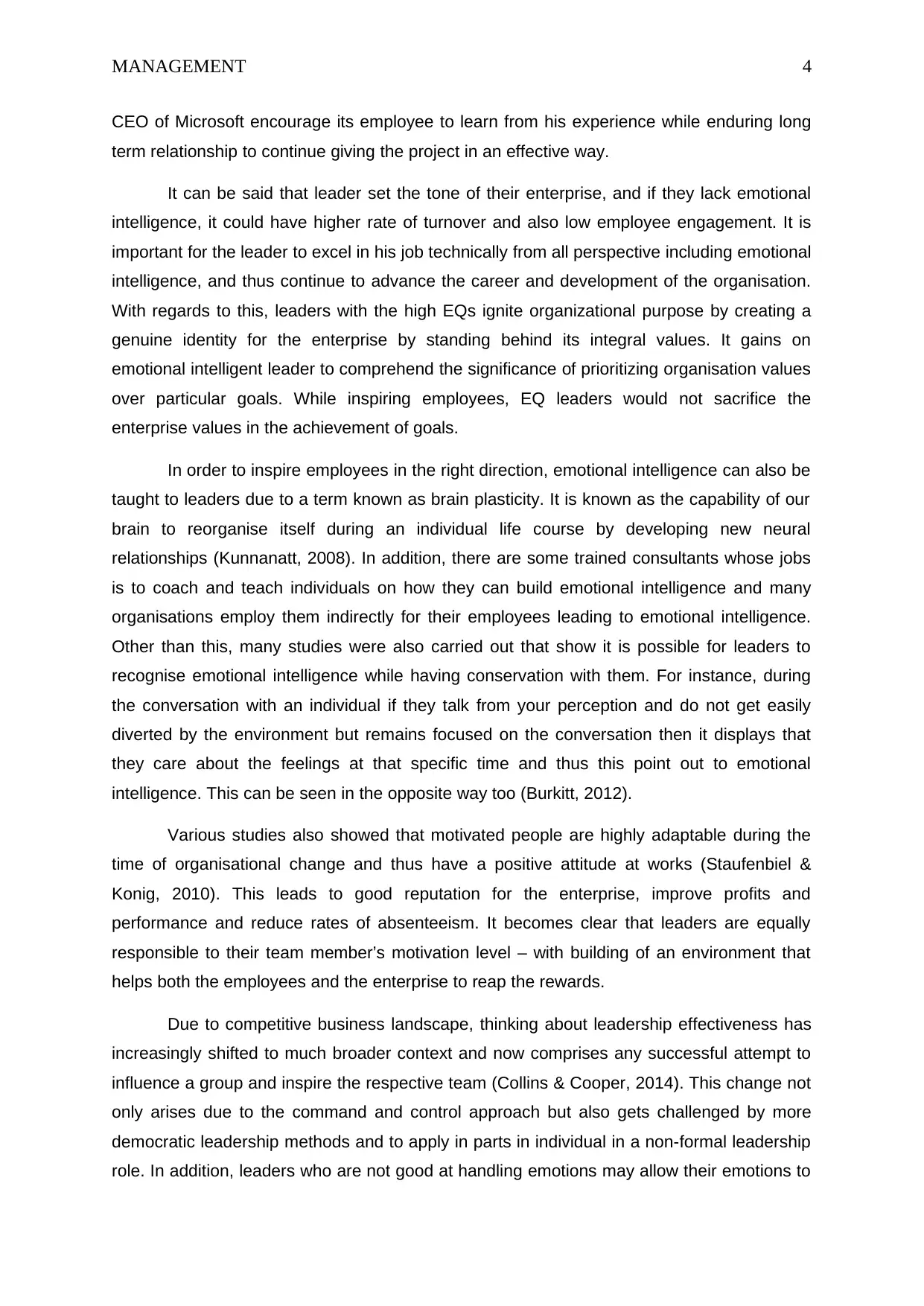
MANAGEMENT 4
CEO of Microsoft encourage its employee to learn from his experience while enduring long
term relationship to continue giving the project in an effective way.
It can be said that leader set the tone of their enterprise, and if they lack emotional
intelligence, it could have higher rate of turnover and also low employee engagement. It is
important for the leader to excel in his job technically from all perspective including emotional
intelligence, and thus continue to advance the career and development of the organisation.
With regards to this, leaders with the high EQs ignite organizational purpose by creating a
genuine identity for the enterprise by standing behind its integral values. It gains on
emotional intelligent leader to comprehend the significance of prioritizing organisation values
over particular goals. While inspiring employees, EQ leaders would not sacrifice the
enterprise values in the achievement of goals.
In order to inspire employees in the right direction, emotional intelligence can also be
taught to leaders due to a term known as brain plasticity. It is known as the capability of our
brain to reorganise itself during an individual life course by developing new neural
relationships (Kunnanatt, 2008). In addition, there are some trained consultants whose jobs
is to coach and teach individuals on how they can build emotional intelligence and many
organisations employ them indirectly for their employees leading to emotional intelligence.
Other than this, many studies were also carried out that show it is possible for leaders to
recognise emotional intelligence while having conservation with them. For instance, during
the conversation with an individual if they talk from your perception and do not get easily
diverted by the environment but remains focused on the conversation then it displays that
they care about the feelings at that specific time and thus this point out to emotional
intelligence. This can be seen in the opposite way too (Burkitt, 2012).
Various studies also showed that motivated people are highly adaptable during the
time of organisational change and thus have a positive attitude at works (Staufenbiel &
Konig, 2010). This leads to good reputation for the enterprise, improve profits and
performance and reduce rates of absenteeism. It becomes clear that leaders are equally
responsible to their team member’s motivation level – with building of an environment that
helps both the employees and the enterprise to reap the rewards.
Due to competitive business landscape, thinking about leadership effectiveness has
increasingly shifted to much broader context and now comprises any successful attempt to
influence a group and inspire the respective team (Collins & Cooper, 2014). This change not
only arises due to the command and control approach but also gets challenged by more
democratic leadership methods and to apply in parts in individual in a non-formal leadership
role. In addition, leaders who are not good at handling emotions may allow their emotions to
CEO of Microsoft encourage its employee to learn from his experience while enduring long
term relationship to continue giving the project in an effective way.
It can be said that leader set the tone of their enterprise, and if they lack emotional
intelligence, it could have higher rate of turnover and also low employee engagement. It is
important for the leader to excel in his job technically from all perspective including emotional
intelligence, and thus continue to advance the career and development of the organisation.
With regards to this, leaders with the high EQs ignite organizational purpose by creating a
genuine identity for the enterprise by standing behind its integral values. It gains on
emotional intelligent leader to comprehend the significance of prioritizing organisation values
over particular goals. While inspiring employees, EQ leaders would not sacrifice the
enterprise values in the achievement of goals.
In order to inspire employees in the right direction, emotional intelligence can also be
taught to leaders due to a term known as brain plasticity. It is known as the capability of our
brain to reorganise itself during an individual life course by developing new neural
relationships (Kunnanatt, 2008). In addition, there are some trained consultants whose jobs
is to coach and teach individuals on how they can build emotional intelligence and many
organisations employ them indirectly for their employees leading to emotional intelligence.
Other than this, many studies were also carried out that show it is possible for leaders to
recognise emotional intelligence while having conservation with them. For instance, during
the conversation with an individual if they talk from your perception and do not get easily
diverted by the environment but remains focused on the conversation then it displays that
they care about the feelings at that specific time and thus this point out to emotional
intelligence. This can be seen in the opposite way too (Burkitt, 2012).
Various studies also showed that motivated people are highly adaptable during the
time of organisational change and thus have a positive attitude at works (Staufenbiel &
Konig, 2010). This leads to good reputation for the enterprise, improve profits and
performance and reduce rates of absenteeism. It becomes clear that leaders are equally
responsible to their team member’s motivation level – with building of an environment that
helps both the employees and the enterprise to reap the rewards.
Due to competitive business landscape, thinking about leadership effectiveness has
increasingly shifted to much broader context and now comprises any successful attempt to
influence a group and inspire the respective team (Collins & Cooper, 2014). This change not
only arises due to the command and control approach but also gets challenged by more
democratic leadership methods and to apply in parts in individual in a non-formal leadership
role. In addition, leaders who are not good at handling emotions may allow their emotions to
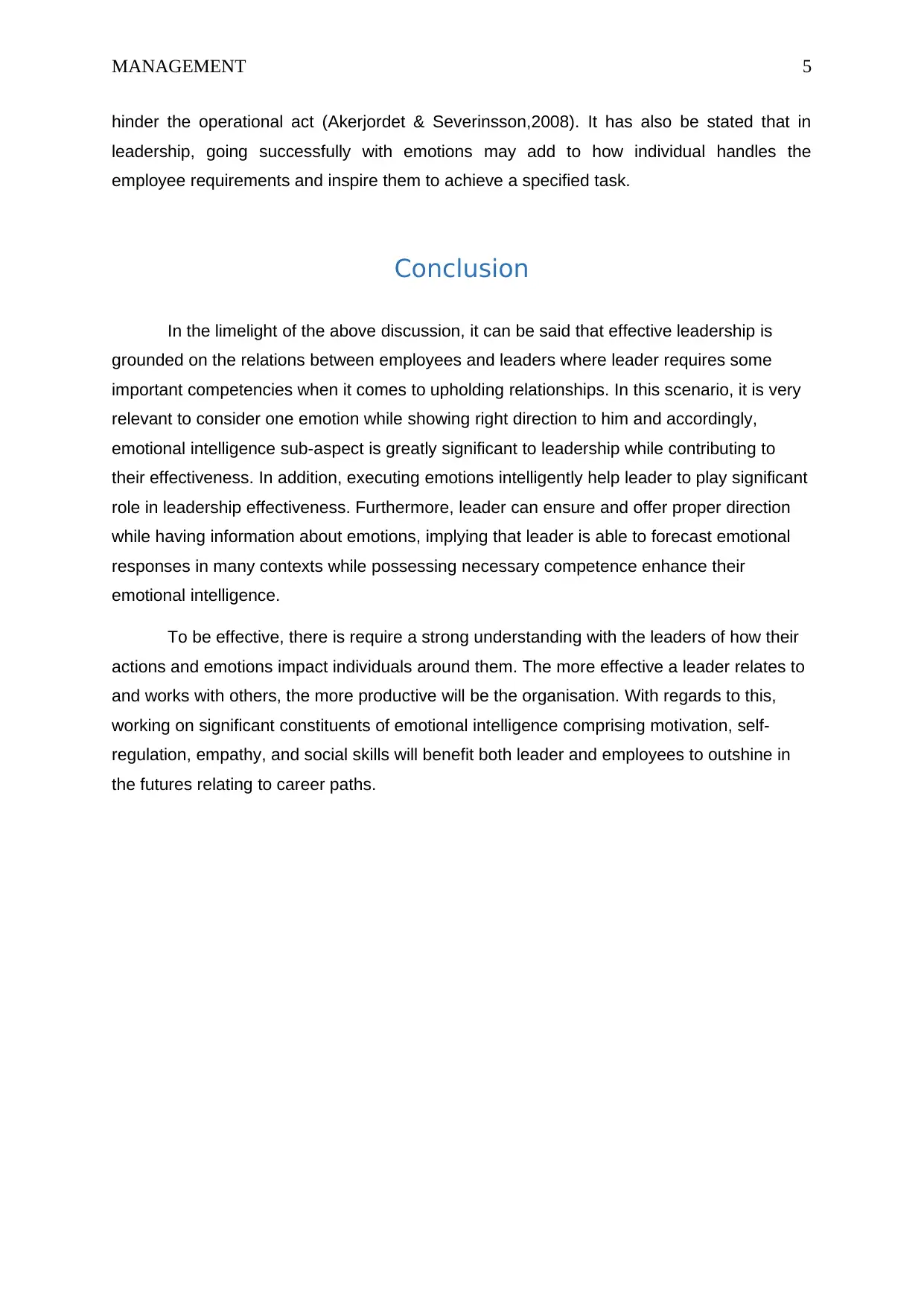
MANAGEMENT 5
hinder the operational act (Akerjordet & Severinsson,2008). It has also be stated that in
leadership, going successfully with emotions may add to how individual handles the
employee requirements and inspire them to achieve a specified task.
Conclusion
In the limelight of the above discussion, it can be said that effective leadership is
grounded on the relations between employees and leaders where leader requires some
important competencies when it comes to upholding relationships. In this scenario, it is very
relevant to consider one emotion while showing right direction to him and accordingly,
emotional intelligence sub-aspect is greatly significant to leadership while contributing to
their effectiveness. In addition, executing emotions intelligently help leader to play significant
role in leadership effectiveness. Furthermore, leader can ensure and offer proper direction
while having information about emotions, implying that leader is able to forecast emotional
responses in many contexts while possessing necessary competence enhance their
emotional intelligence.
To be effective, there is require a strong understanding with the leaders of how their
actions and emotions impact individuals around them. The more effective a leader relates to
and works with others, the more productive will be the organisation. With regards to this,
working on significant constituents of emotional intelligence comprising motivation, self-
regulation, empathy, and social skills will benefit both leader and employees to outshine in
the futures relating to career paths.
hinder the operational act (Akerjordet & Severinsson,2008). It has also be stated that in
leadership, going successfully with emotions may add to how individual handles the
employee requirements and inspire them to achieve a specified task.
Conclusion
In the limelight of the above discussion, it can be said that effective leadership is
grounded on the relations between employees and leaders where leader requires some
important competencies when it comes to upholding relationships. In this scenario, it is very
relevant to consider one emotion while showing right direction to him and accordingly,
emotional intelligence sub-aspect is greatly significant to leadership while contributing to
their effectiveness. In addition, executing emotions intelligently help leader to play significant
role in leadership effectiveness. Furthermore, leader can ensure and offer proper direction
while having information about emotions, implying that leader is able to forecast emotional
responses in many contexts while possessing necessary competence enhance their
emotional intelligence.
To be effective, there is require a strong understanding with the leaders of how their
actions and emotions impact individuals around them. The more effective a leader relates to
and works with others, the more productive will be the organisation. With regards to this,
working on significant constituents of emotional intelligence comprising motivation, self-
regulation, empathy, and social skills will benefit both leader and employees to outshine in
the futures relating to career paths.
⊘ This is a preview!⊘
Do you want full access?
Subscribe today to unlock all pages.

Trusted by 1+ million students worldwide
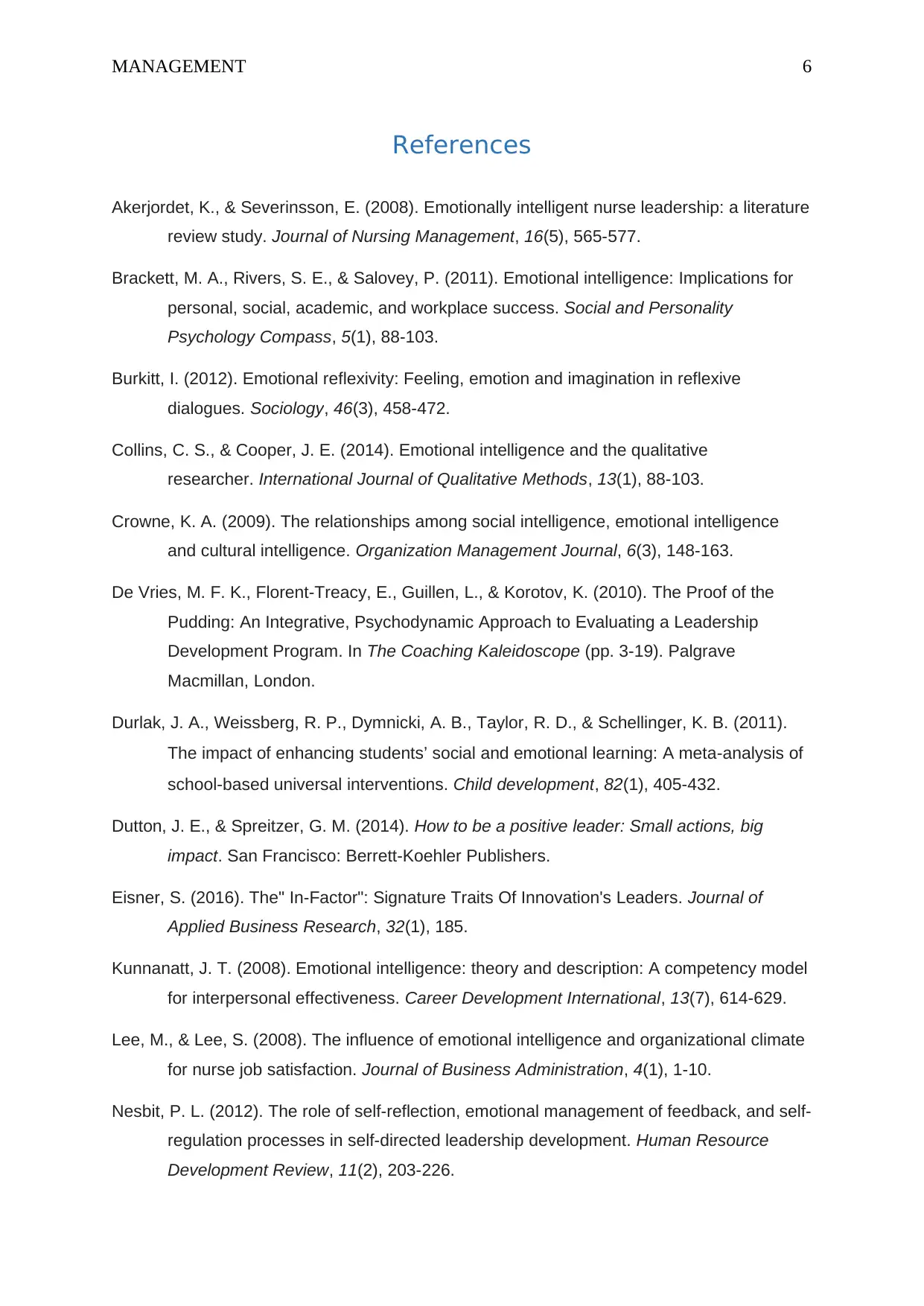
MANAGEMENT 6
References
Akerjordet, K., & Severinsson, E. (2008). Emotionally intelligent nurse leadership: a literature
review study. Journal of Nursing Management, 16(5), 565-577.
Brackett, M. A., Rivers, S. E., & Salovey, P. (2011). Emotional intelligence: Implications for
personal, social, academic, and workplace success. Social and Personality
Psychology Compass, 5(1), 88-103.
Burkitt, I. (2012). Emotional reflexivity: Feeling, emotion and imagination in reflexive
dialogues. Sociology, 46(3), 458-472.
Collins, C. S., & Cooper, J. E. (2014). Emotional intelligence and the qualitative
researcher. International Journal of Qualitative Methods, 13(1), 88-103.
Crowne, K. A. (2009). The relationships among social intelligence, emotional intelligence
and cultural intelligence. Organization Management Journal, 6(3), 148-163.
De Vries, M. F. K., Florent-Treacy, E., Guillen, L., & Korotov, K. (2010). The Proof of the
Pudding: An Integrative, Psychodynamic Approach to Evaluating a Leadership
Development Program. In The Coaching Kaleidoscope (pp. 3-19). Palgrave
Macmillan, London.
Durlak, J. A., Weissberg, R. P., Dymnicki, A. B., Taylor, R. D., & Schellinger, K. B. (2011).
The impact of enhancing students’ social and emotional learning: A meta‐analysis of
school‐based universal interventions. Child development, 82(1), 405-432.
Dutton, J. E., & Spreitzer, G. M. (2014). How to be a positive leader: Small actions, big
impact. San Francisco: Berrett-Koehler Publishers.
Eisner, S. (2016). The" In-Factor": Signature Traits Of Innovation's Leaders. Journal of
Applied Business Research, 32(1), 185.
Kunnanatt, J. T. (2008). Emotional intelligence: theory and description: A competency model
for interpersonal effectiveness. Career Development International, 13(7), 614-629.
Lee, M., & Lee, S. (2008). The influence of emotional intelligence and organizational climate
for nurse job satisfaction. Journal of Business Administration, 4(1), 1-10.
Nesbit, P. L. (2012). The role of self-reflection, emotional management of feedback, and self-
regulation processes in self-directed leadership development. Human Resource
Development Review, 11(2), 203-226.
References
Akerjordet, K., & Severinsson, E. (2008). Emotionally intelligent nurse leadership: a literature
review study. Journal of Nursing Management, 16(5), 565-577.
Brackett, M. A., Rivers, S. E., & Salovey, P. (2011). Emotional intelligence: Implications for
personal, social, academic, and workplace success. Social and Personality
Psychology Compass, 5(1), 88-103.
Burkitt, I. (2012). Emotional reflexivity: Feeling, emotion and imagination in reflexive
dialogues. Sociology, 46(3), 458-472.
Collins, C. S., & Cooper, J. E. (2014). Emotional intelligence and the qualitative
researcher. International Journal of Qualitative Methods, 13(1), 88-103.
Crowne, K. A. (2009). The relationships among social intelligence, emotional intelligence
and cultural intelligence. Organization Management Journal, 6(3), 148-163.
De Vries, M. F. K., Florent-Treacy, E., Guillen, L., & Korotov, K. (2010). The Proof of the
Pudding: An Integrative, Psychodynamic Approach to Evaluating a Leadership
Development Program. In The Coaching Kaleidoscope (pp. 3-19). Palgrave
Macmillan, London.
Durlak, J. A., Weissberg, R. P., Dymnicki, A. B., Taylor, R. D., & Schellinger, K. B. (2011).
The impact of enhancing students’ social and emotional learning: A meta‐analysis of
school‐based universal interventions. Child development, 82(1), 405-432.
Dutton, J. E., & Spreitzer, G. M. (2014). How to be a positive leader: Small actions, big
impact. San Francisco: Berrett-Koehler Publishers.
Eisner, S. (2016). The" In-Factor": Signature Traits Of Innovation's Leaders. Journal of
Applied Business Research, 32(1), 185.
Kunnanatt, J. T. (2008). Emotional intelligence: theory and description: A competency model
for interpersonal effectiveness. Career Development International, 13(7), 614-629.
Lee, M., & Lee, S. (2008). The influence of emotional intelligence and organizational climate
for nurse job satisfaction. Journal of Business Administration, 4(1), 1-10.
Nesbit, P. L. (2012). The role of self-reflection, emotional management of feedback, and self-
regulation processes in self-directed leadership development. Human Resource
Development Review, 11(2), 203-226.
Paraphrase This Document
Need a fresh take? Get an instant paraphrase of this document with our AI Paraphraser
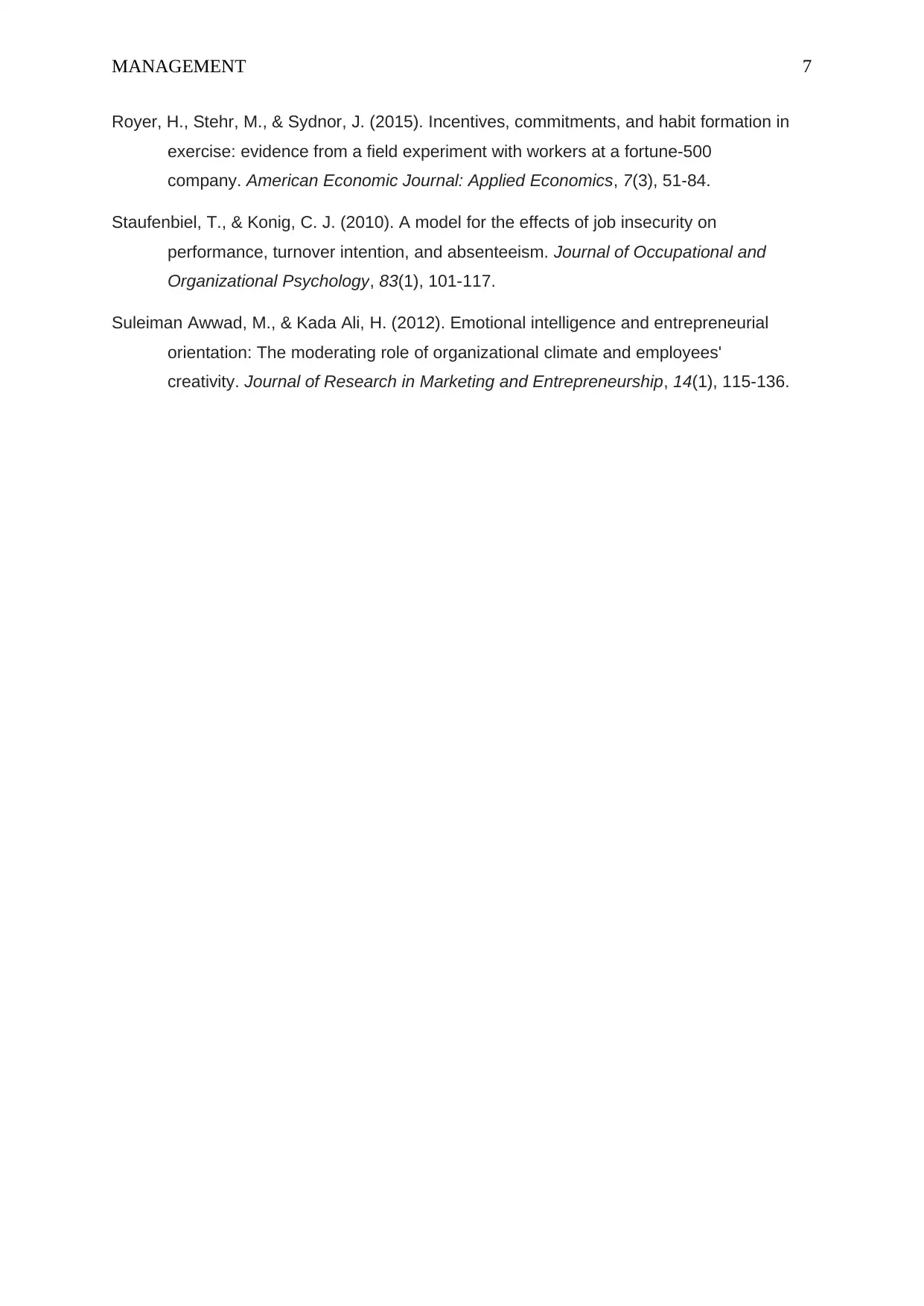
MANAGEMENT 7
Royer, H., Stehr, M., & Sydnor, J. (2015). Incentives, commitments, and habit formation in
exercise: evidence from a field experiment with workers at a fortune-500
company. American Economic Journal: Applied Economics, 7(3), 51-84.
Staufenbiel, T., & Konig, C. J. (2010). A model for the effects of job insecurity on
performance, turnover intention, and absenteeism. Journal of Occupational and
Organizational Psychology, 83(1), 101-117.
Suleiman Awwad, M., & Kada Ali, H. (2012). Emotional intelligence and entrepreneurial
orientation: The moderating role of organizational climate and employees'
creativity. Journal of Research in Marketing and Entrepreneurship, 14(1), 115-136.
Royer, H., Stehr, M., & Sydnor, J. (2015). Incentives, commitments, and habit formation in
exercise: evidence from a field experiment with workers at a fortune-500
company. American Economic Journal: Applied Economics, 7(3), 51-84.
Staufenbiel, T., & Konig, C. J. (2010). A model for the effects of job insecurity on
performance, turnover intention, and absenteeism. Journal of Occupational and
Organizational Psychology, 83(1), 101-117.
Suleiman Awwad, M., & Kada Ali, H. (2012). Emotional intelligence and entrepreneurial
orientation: The moderating role of organizational climate and employees'
creativity. Journal of Research in Marketing and Entrepreneurship, 14(1), 115-136.
1 out of 8
Related Documents
Your All-in-One AI-Powered Toolkit for Academic Success.
+13062052269
info@desklib.com
Available 24*7 on WhatsApp / Email
![[object Object]](/_next/static/media/star-bottom.7253800d.svg)
Unlock your academic potential
Copyright © 2020–2025 A2Z Services. All Rights Reserved. Developed and managed by ZUCOL.





